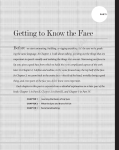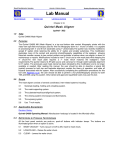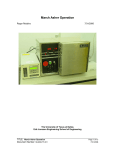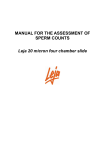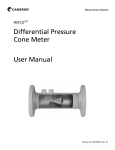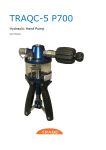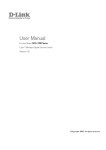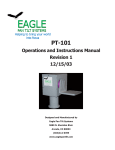Download Contact Photolithographic Alignment Tutorial
Transcript
1 Alignment Tutorial Electrical and Computer Engineering Department, Brigham Young University Contact Photolithographic Alignment Tutorial Aaron R. Hawkins January, 2004 1.0 Introduction Contact aligners are used in most microfabrication research laboratories and in even in lowvolume production facilities. Almost any microscale device or structure requires more than one photomask step. The job of the contact aligner is to allow its user to align features on a substrate (wafer) to features on a photomask. The production of sophisticated electronic devices may involve ten or more of these alignment steps. The purpose of this tutorial is to give some guidance to new contact aligner users on how actual alignment between a wafer and a photomask should be done. This document does not attempt to describe the use of any particular piece of equipment but rather attempts to give a general outline of alignment that could be applied to any aligner. Because new users of contact aligners are usually working with intact, round substrates and split screen microscopes, the examples illustrated in this document will include these elements. After describing the basic mechanisms of all contact aligners, alignment steps will be outlined from wafer loading to exposure. 2.0 Contact Aligners 2.1 Elements of a typical contact aligner Although there are many manufacturers and models of contact aligners, they all have the same features. Figure 1 illustrates these features. It is important for new users of any particular aligner to identify these features for their machine. Knob controls focus of microscope Knob controls lateral position of left objective Exposure Timer Joystick or switch controls rotation movement of microscope Knob controls lateral position of right objective Microscope Objective Microscope Objective Mask Wafer Joystick or switch controls x-y movement of microscope Wafer Chuck Mask Holder Spacing Setting Joystick or switch controls rotation movement of mask or wafer Joystick or switch controls x-y movement of mask or wafer Figure 1: Elements of a contact aligner including: mask holder, wafer chuck, microscope, microscope positioners (x, y, z, theta) and lateral separation, wafer or mask positioners (x, y, z, theta), separation adjustments, exposure timer. Each of the important functions illustrated in Figure 1 are described below: 1. Mask Holder – this is typically a very flat piece of metal that holds the photomask in place. The mask holder has a large hole in its center through which a wafer will be placed in contact with the mask. The mask holder has vacuum holes around its edge that keep the photomask securely in place during the alignment procedure. Alignment Tutorial Electrical and Computer Engineering Department, Brigham Young University 2 2. Wafer Chuck – this is a very flat piece of metal that holds the wafer in place using vacuum holes throughout its surface. The wafer chuck moves up and down to bring the wafer into contact with the photomask or pull it away from the photomask. The wafer chuck is designed to fit through the hole in the middle of the mask holder. 3. Microscope – this is required to do high-resolution alignment. Most aligners have at least 20X microscope objectives to allow for alignment resolutions down to 1 micron. Some aligners have several objectives available on a rotating objective head (5X, 10X, and 20X). Most aligners use two objectives and a split screen that allows the user to see points on opposite sides of a wafer at the same time. 4. Microscope Positioner – this allows the microscope to be moved to different x-y positions over the surface of a mask or wafer as well as different angle rotations. Movement is usually done using a joystick or switch controller with different controls for the x-y movement and angle rotation. 5. Lateral Objective Positioner – this allows the distance between the microscope’s objectives to be changed. This allows the user to view points on either side of a wafer near its edges, or closer to its interior. This adjustment is critical because alignment marks on photomasks are not always spaced by the same distance. 6. Wafer/Mask Positioner – this allows for the wafer to be moved to different x-y positions or different angle rotations in relation to the mask. In some aligners the mask is held still while the wafer is moved below it and in other aligners the wafer is held still and the mask is moved above it. Movement is usually done using a joystick, switch controller, or micrometers with different controls for the x-y movement and angle rotation. 7. Wafer Separation Setting – this allows a user to set the separation between the wafer and the photomask during the alignment procedure. The closer the separation the easier it will be for the microscope to resolve features on the photomask and wafer at the same time – important for high resolution alignment. If the separation is set too close and the mask and wafer are not perfectly parallel, the wafer will get stuck to the photomask and alignment will be very difficult. A typical separation is around 25 microns. 8. Exposure Timer – this allows a user to set the exposure time for the aligner (how long the wafer and mask will be exposed to UV light) 9. Contact Command – this allows a user to bring the wafer up into contact with the photomask. This is usually accomplished after alignment is complete and before exposure is to take place. There is typically a “Separation” command on most aligners as well that allows a user to move the wafer away from the mask again if they want to continue to refine the alignment. The “Contact” control button is not illustrated in Figure 1 but is found on typical aligners. 10. Expose Command – this command begins the exposure process and UV light is flooded over the mask and wafer for the exposure time set by the user. The “Expose” control button is not illustrated in Figure 1 but is found on typical aligners. 2.2 Wedge Compensation Wedge compensation is a function that most contact aligners do automatically to try and compensate for any lack of parallelism between a wafer or wafer chuck and a photomask. The basic steps of wedge compensation are illustrated in Figure 2. During wedge compensation the wafer is pushed against the photomask using air pressure. The wafer chuck “floats” on a bed of Alignment Tutorial Electrical and Computer Engineering Department, Brigham Young University 3 air and when it has adjusted itself so that it is flat against the mask, it is mechanically locked into place. The wafer is then moved away from the photomask a pre-specified amount – the separation setting described in Section 2.1. Alignment is done with this gap between the mask and the wafer. After the wafer is aligned, it is usually pushed back up in contact with the mask before it is exposed to UV light. Step 1 - Wafer put in aligner - possibly tilted in relation to mask Mask Wafer Step 2 - Wafer is pushed up in contact with mask and made level with the mask Step 3 - Wafer leveling is locked and then wafer separated from mask for alignment separation Mask Holder Wafer Chuck pressure Figure 2: Side view of what happens when a wafer is loaded into a contact aligner. The aligner is designed to correct any non-parallelism that might exist between the wafer and the mask. It can then separate the mask and wafer to a specific distance to allow for alignment. 2.3 Need for Alignment Adjustments Section 2.1 outlined the many features of a contact aligner. These allow for changing the x, y, and z positions and angular orientation of a wafer or mask and the same change in positioning for a microscope above the mask/wafer. For a new user, this might seem like an overcomplication of the adjustments necessary for alignment. Figure 3: Top view example of how a wafer, a mask, and the viewing microscope of the aligner may be oriented when the wafer is first loading into the aligner. This demonstrates the need for all the adjustments the aligner is capable of. To correctly align the wafer to the mask we need to be able to adjust: 1) the rotation of the microscope 2) the lateral position of the microscopes objectives 3) the position of the objectives over the alignment marks 4) the rotation of the wafer in relation to the mask 5) the x-y position of the wafer in relation to the mask. Alignment Tutorial Electrical and Computer Engineering Department, Brigham Young University 4 Figure 3 illustrates why all of these adjustments are necessary. This figure shows a top view of an example of what can happen when an arbitrary wafer and mask are loaded into an aligner for the first time. The alignment marks between the wafer and the mask will not be in the correct place requiring adjustment. In addition the microscope objectives will not necessarily be in the right place – requiring some adjustment so that they are positioned over the alignment marks. 3.0 Alignment Procedures The following steps describe the procedure for aligning a feature on a wafer to a feature on a photomask. These features are called alignment marks and it is assumed that these marks can be easily seen through a microscope on the surface of a wafer and on a photomask. It is assumed that the alignment mark on the wafer had been etched into the wafer after a previous photolithography step. It is required of the lithography to know what marks on the wafer are supposed to line up with what marks on the mask – which can get complicated after several masking steps. No discussion is given on the correct design for alignment marks although good alignment marks can make alignment much easier. In all of the illustrations used in this section, these marks are simply shown as crosses that are supposed to line up on top of each other. 3.1 Load your mask and your wafer The description of how to load your wafer and mask into your aligner will be very specific to the machine you are using and will not be attempted here. Some machines have auto-loading and pre-alignment features while others are very manual in their loading procedures. Consult the machines user manual or manufacturer for specific instructions. Before loading, you should set the wafer separation distance and exposure time on the aligner. 3.2 Align Microscope Objectives to Mask Alignment Marks Once a wafer and a mask are loaded into the aligner, the first adjustment should be the position of the microscope objectives. To be able to properly align the wafer and the mask, you must first Figure 4: Top view diagram showing how we want to move our microscope objectives over the top of the mask alignment marks. In (a) we first must rotate the microscope assembly clockwise so that the microscope objectives are parallel to the mask alignment marks. In (b) we increase the lateral separation between the objectives so they both can be positioned over an alignment mark on either side of the wafer. We also adjust the x-y position of the microscope to align both objectives to the alignment marks. Part (c) shows correctly positioned objectives over the masks alignment marks. 5 Alignment Tutorial Electrical and Computer Engineering Department, Brigham Young University be able to see the alignment marks using the microscope. Figure 4 shows an example situation in which we begin with a misoriented wafer and microscope. In Figure 4 (a) the microscope is rotated clockwise until the objectives are parallel with the alignment marks on the mask. The objectives are then moved out laterally until they are spaced properly so that an alignment mark can be seen in each objective. X-Y position adjustments are also done on the microscope objectives until they are directly above the alignment marks. Figure 5 illustrates what the user should see in the microscope view once the microscope is properly aligned to the alignment marks on the mask. Once both marks are in view, slight adjustments in rotation angle and x-y position are made until the marks appear exactly parallel as illustrated in Figure 5. When looking through the microscope, be sure you are focused on the photomask and aligning to it and not the wafer below it. View from Left Objective View from Right Objective Alignment marks parallel to each other Figure 5: View in the microscope corresponding to the alignment position shown in Figure 4(c). This figure assumes a split view for the microscope and the mask’s alignment marks are positioned in the middle of each objective’s view. The microscope should be adjusted so that the marks are parallel to each other. 3.3 Move A Wafer Alignment Mark Close to a Mask Alignment Mark After the microscope objectives are positioned over the mask’s alignment marks, the next step is to move one of the wafer alignment marks in close proximity to one of the mask alignment marks. The position of the microscope in relation to the mask should not change. For aligners that keep the wafer still and move the photomask over it for alignment, this means that the microscope’s position will have to be locked in reference to the photomask. If you are using this type of aligner there will be a control button to lock the microscopes relative position in this way. At this point it is easiest to concentrate on matching only one mask alignment mark to one wafer alignment mark. Some aligners allow you to turn off the split screen viewing so you can see a larger field of view for one objective at a time. This can be very useful when you are trying to find a wafer alignment mark and move it toward a mask alignment mark. Figure 6 illustrates the idea behind this step. In the example in this figure, the wafer has to be shifted toward the right and slightly up so that the alignment mark can be viewed by the left objective. The rotation of the wafer is not necessarily parallel with that for the mask as shown in Alignment Tutorial Electrical and Computer Engineering Department, Brigham Young University 6 both Figure 6 and Figure 7 that shows a microscope view of the photomask’s and wafers alignment marks in close proximity. Figure 6: Top view diagram showing how we move an alignment mark on the wafer near one of the alignment marks on the mask. The x-y position of the wafer is moved in relation to the photomask. View from Left Objective Figure 7: View in the left microscope objective after the adjustments done in Figure 6(b). The alignment mark on the mask is in black and the alignment mark on the wafer is below that in gray. The rotation orientations between the mask and the wafer have not been adjusted yet so the alignment marks aren’t necessarily parallel at this point. 3.4 Rotate Your Wafer to Approximate Alignment When the x-y position of the wafer alignment mark is positioned near the photomask alignment mark, the rotation of the wafer can now be changed so that the alignment marks are parallel. As in Section 3.3, this is often most easily accomplished when looking through only one objective at a time (no split screen). As illustrated in Figure 8 and 9, the rotation angle is changed for the wafer so that alignment marks are parallel. In the example shown in these figures the wafer requires counter-clockwise rotation in order to match up with the photomask. The most important part of this step is simply matching up the parallelism of the alignment marks but not necessarily the x-y positions as shown in Figure 9. Alignment Tutorial Electrical and Computer Engineering Department, Brigham Young University 7 Figure 8: Top view diagram showing how we rotate the wafer counter-clockwise in order to match the rotation orientation of the wafer and the mask. Part (a) shows the situation before rotation and (b) after the mask and wafers orientations are approximately matched. View from Left Objective Alignment marks parallel but not necessarily perfectly aligned in x-y Figure 9: Microscope view of the left objective after the adjustment made in Figure 8. The alignment mark on the mask is in black and the alignment mark on the wafer is below that in gray. The rotation orientations have now been adjusted so that the two marks are now approximately parallel but not necessarily perfectly aligned in x-y. 3.5 Refine Wafer Rotation Using Split Screen Even if alignment marks appear to be parallel using a single objective view (Figure 9), any deviation in rotation angle will show up when we view the alignment marks using both objectives. Figure 10 shows an illustration of a split-screen view of alignment marks in which the alignment marks on the left appear to be matched, but the alignment marks on the right reveal that there is still a slight rotation of the angle of the wafer compared to the mask. Wafer rotation can be further refined by viewing both alignment marks while doing slight angle adjustments. In the example shown in Figure 10, the wafer still needs some slight counter-clockwise rotation for the alignment marks to match on both sides of the wafer. 8 Alignment Tutorial Electrical and Computer Engineering Department, Brigham Young University View from Left Objective View from Right Objective (a) View from Left Objective View from Right Objective (b) Figure 10: Microscope view of both objectives showing the change in rotation still necessary for perfect alignment. Part (a) shows how the two alignment marks may appear to be parallel using only the left alignment marks, but may not be parallel over the entire wafer. To get perfect alignment a slight counterclockwise rotation is still required for this example. Part (b) shows a wafer that has now been rotated so that the wafer and the mask are now perfectly parallel. 3.6 Align X-Y Coordinates Now that the mask alignment marks are now parallel to the wafer alignment marks, the x-y positioning of the wafer can be changed so that the alignment marks are exactly matched as shown in Figure 11. In this figure, the wafer has to be shifted slightly to the left for perfect x-y alignment. View from Left Objective View from Right Objective (a) View from Left Objective View from Right Objective (b) Figure 11: Microscope view of both objectives showing the change in x-y position still necessary for perfect alignment. Part (a) shows how the alignment marks are parallel but may not be exactly positioned. To get perfect alignment a slight left movement of the wafer in relation to the mask is still required for this example. Part (b) shows a wafer that has now been perfectly aligned with the alignment marks of the wafer matched to the alignment marks of the mask. 3.7 Check Wafer in Contact When the wafer has finally been aligned completely with the photomask, the wafer should now be moved up into contact with the mask using the “Contact” command button. Unfortunately if the wafer or the mask are not held down tightly against the wafer chuck and mask holder respectively, when the wafer contacts the mask there can be a small shift in the wafer’s position 9 Alignment Tutorial Electrical and Computer Engineering Department, Brigham Young University with respect to the mask. This situation is illustrated in Figure 12. The alignment should be checked in the microscope after contact is made to make sure a shift has not occurred. If a shift has occurred, the wafer should be moved back into separation and the wafer realigned. View from Left Objective View from Right Objective (a) View from Left Objective View from Right Objective (b) Figure 12: Illustration of what can happen when a wafer is moved from the being separated from the mask and into contact with the mask. Part (a) shows the wafer in perfect alignment with the mask in separation mode. When moved into contact, the wafer can shift slightly and the perfect alignment can be compromised as shown in part (b). 3.8 Exposure When the mask and the wafer are correctly aligned in “Contact,” the “Exposure” button should then be pressed. The wafer will be exposed for the time set by the exposure time. After UV exposure, most aligners will move the wafer away from the mask preparing it for removal from the machine. 4.0 Further Alignments If more wafers are to be aligned to the same photomask, the photomask can be kept in the mask holder and the microscope kept in the position we have already aligned to. After loading subsequent wafers, they now need only to be aligned to the photomask alignment marks (Sections 3.3 – 3.8). If you are doing further alignments using a new photomask, the earlier photomask must be released from the mask holder and a new mask installed. After the new mask and a new wafer are loaded into the aligner, all the alignment procedures must now be repeated (Section 3.2 – 3.8).









